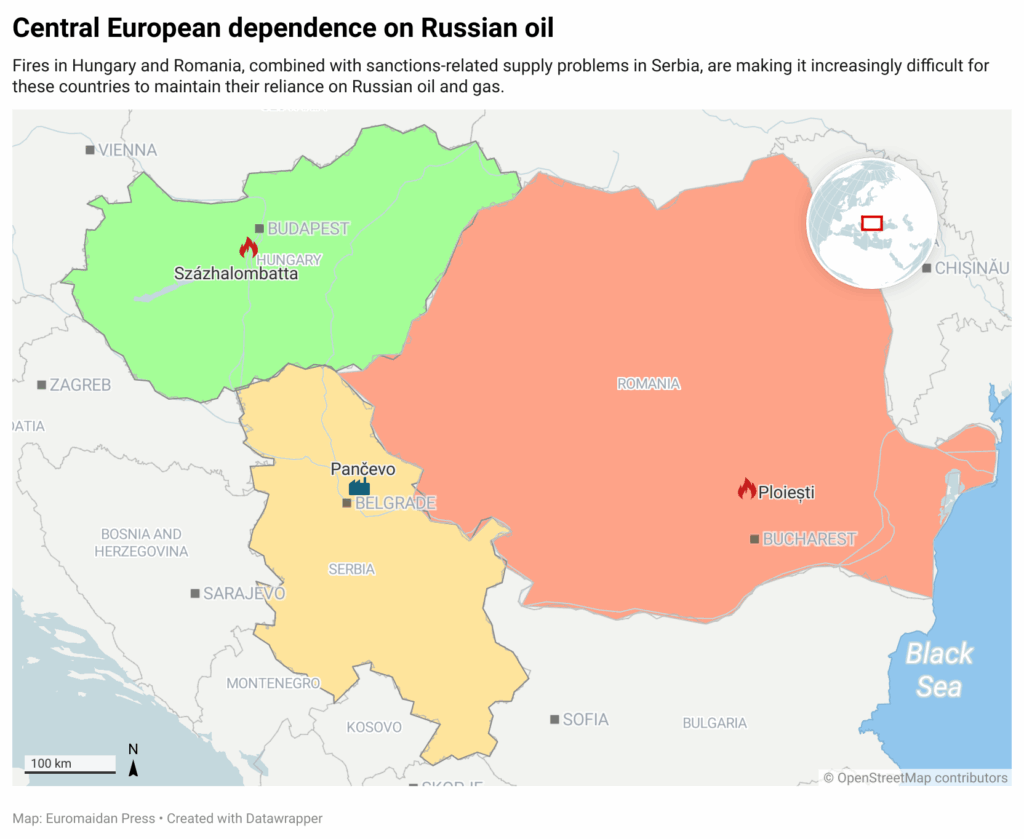An explosion ripped through Hungary’s largest oil refinery hours after a blast hit a Russian-owned Romanian facility—both processing Russian crude on the same day Ukraine’s drones struck deep inside Russia.
The twin incidents hit countries that maintained Russian energy dependence while blocking Ukraine aid. These countries now face the consequences as Hungary loses critical refining capacity and alternative supplies dry up across the region.
Százhalombatta fire knocks out significant capacity
A fire broke out at MOL’s Danube Refinery in Százhalombatta late on 20 October, engulfing the facility’s largest processing unit, which has an annual capacity of 3 million tonnes. Reuters reported that the unit processes over 40% of the refinery’s crude intake, making it critical to Hungary’s fuel supply.
MOL confirmed that no one was injured, adding that investigations found “no signs of external tampering.”
On Tuesday’s press conference, Krisztián Pulay, the company’s Director of Operations, said restoration could take “the next few days.” However, Erste Bank analyst Tamás Pletser estimated the capacity loss could persist for months.
Hungarian business outlet Világgazdaság reported that authorities are examining technical failure, human error, and the possibility of “organized action.”
Prime Minister of Hungary, Viktor Orbán, promised to investigate “as thoroughly as possible” while assuring that fuel supplies remain secure.
The facility processes primarily Russian crude delivered via the Druzhba pipeline—a rarity in the European Union, where most member states slashed Russian energy imports following Moscow’s 2022 invasion of Ukraine.

Same-day explosion in Romania
Hours earlier that Monday, an explosion struck the Petrotel-Lukoil refinery in Ploiești, Romania. The Russian-owned facility, one of Romania’s largest with 2.5 million tonnes annual capacity, was offline for scheduled maintenance when the blast injured a 57-year-old worker.
The Hungarian Conservative noted that “the near-simultaneous incidents have fueled speculation of Ukrainian sabotage amid Kyiv’s ongoing drone and pipeline attacks on Russian energy infrastructure.”
Ukraine has not commented on either incident. The Kyiv Independent reported that Ukrainian officials declined to address the explosions or a separate drone strike that same day on Russia’s Novokuybyshevsk refinery.
Ukraine’s refinery campaign
This comes as Ukraine has spent months targeting Russian oil infrastructure. Between August and September alone, Ukrainian forces confirmed 23 successful strikes on Russian refineries, focusing on atmospheric vacuum distillation units that can halt production entirely.
Ukrainian drones have reached facilities over 1,300 kilometers inside Russia, including repeat strikes on the Gazprom Neftekhim Salavat refinery in Bashkortostan and attacks on the Novokuybyshevsk facility in Samara Oblast.
In March, Ukrainian strikes on Druzhba pipeline control stations disrupted oil exports to Hungary for several days.
Hungarian Foreign Minister Péter Szijjártó called the attack on the pipeline—which supplies over 40% of Hungary’s oil—an assault on the country’s sovereignty and banned the Ukrainian drone commander from the Schengen area.
Poland recently refused to extradite a Ukrainian citizen accused of involvement in the 2022 Nord Stream pipeline sabotage, with Prime Minister Donald Tusk stating it was “not in Poland’s national interest.” Szijjártó condemned the decision as giving “advance permission for terrorist attacks in Europe.”
Trending Now
Serbia’s compounding crisis
The MOL fire arrives at a critical moment for Serbia. After multiple delays, US Treasury sanctions targeting the country’s NIS oil company—45% owned by Gazprom Neft—took effect on 8 October.
The sanctions block NIS from importing crude oil. Without new supplies, Serbia’s Pančevo refinery—the country’s only significant fuel processing facility—could be shut down within one to six weeks, according to energy analysts.
Erste’s Pletser warned that the MOL fire makes Serbia’s situation “even more dire.”
MOL announced plans to increase fuel deliveries to Serbia following the sanctions, but the refinery damage now eliminates that option.
Serbia also faces pressure on natural gas. Gazprom declined to renew a long-term supply contract, offering only deliveries through year-end. President Aleksandar Vučić stated Washington wants Serbia to nationalize NIS and Gazprom-owned gas infrastructure to lift sanctions, but called such action “the last thing I would do.”
Pletser noted that Vučić faces a difficult choice: maintain Russian ties and risk energy paralysis, or break with Moscow and confront his nationalist voter base.
Strategic vulnerability
Countries that built energy systems around Russian supplies now face rapid collapse. By May 2025, Hungary imported 90% of its gas and 65% of its oil from Russia despite having access to the Adria pipeline from Croatia, which Croatian operator JANAF confirmed can transport 14.3 million tonnes annually—exceeding MOL’s refinery needs.
A May 2025 study documented that Hungary and Slovakia knowingly depend on Russian energy despite available alternatives.
According to the report “The Last Mile. Phasing Out Russian Oil and Gas in Central Europe”, MOL contracted 2.2 million tonnes via Adria in 2024 while continuing to process discounted Russian crude: “...however, only 968 thousand tonnes were actually delivered...”
The European Union plans to phase out all Russian gas, oil, and coal imports by 2027-2028, though Hungary has threatened to veto sanctions if its Russian oil exemption is revoked.
Hungary and Serbia have been among Europe’s most vocal opponents of military aid to Ukraine.
Orbán blocked or delayed multiple billion-dollar EU aid packages, while Serbia refused to join Western sanctions against Russia.
As Russia continues its systematic campaign targeting Ukraine’s energy grid—destroying over 50% of pre-war generating capacity in 2025—the question of energy vulnerability has taken on new dimensions across the region.

